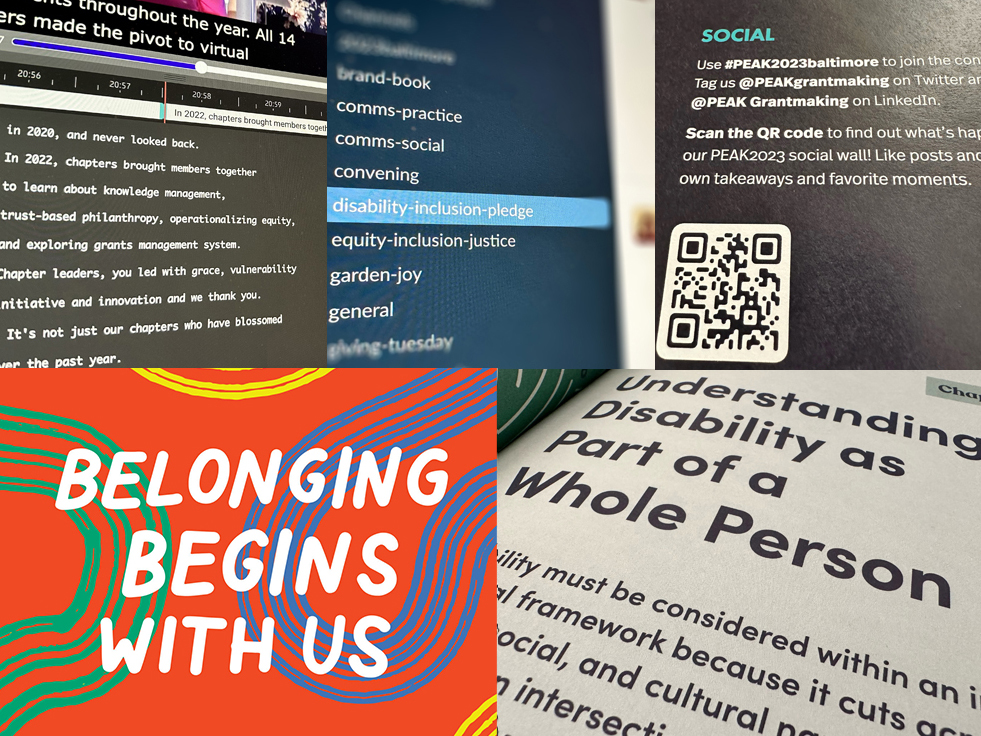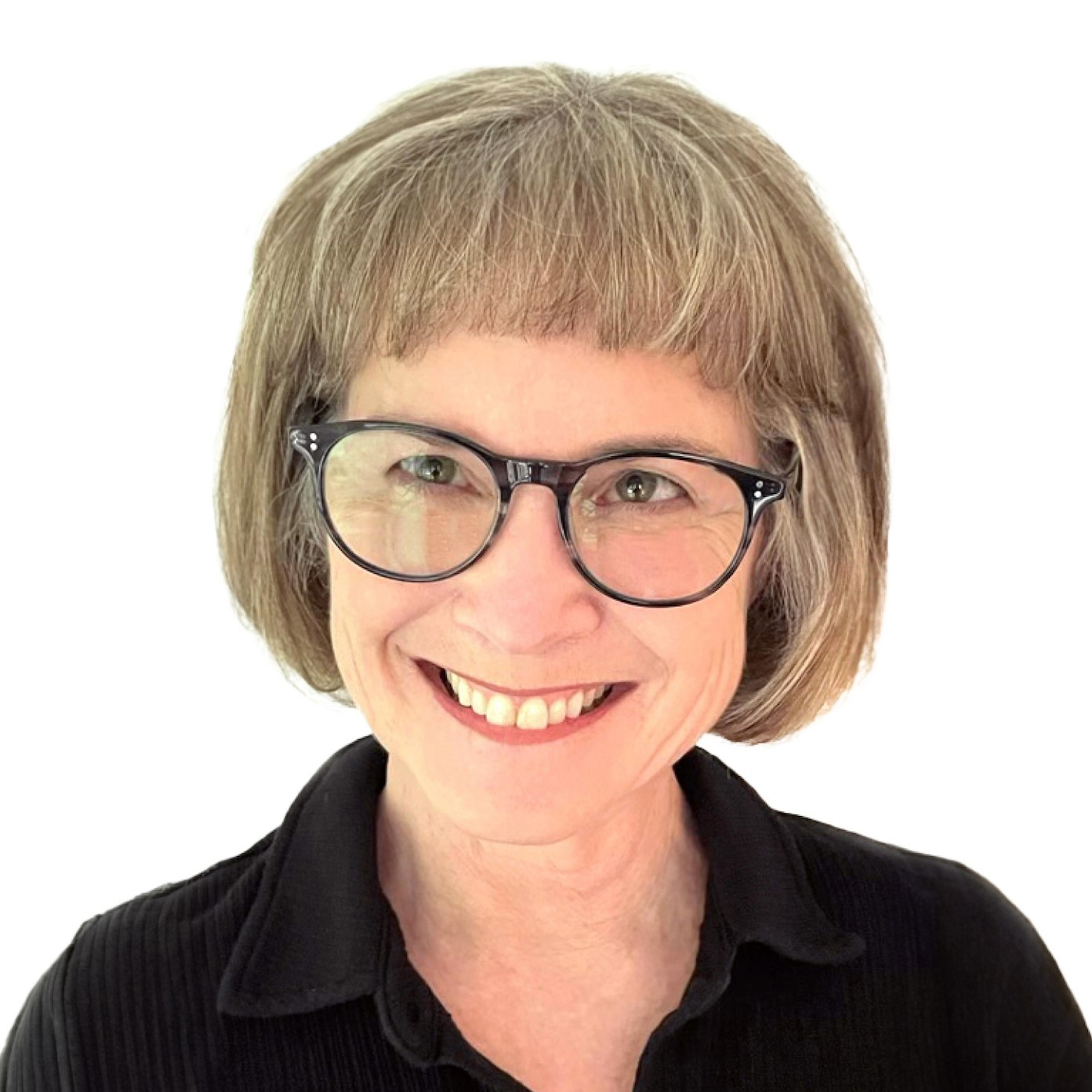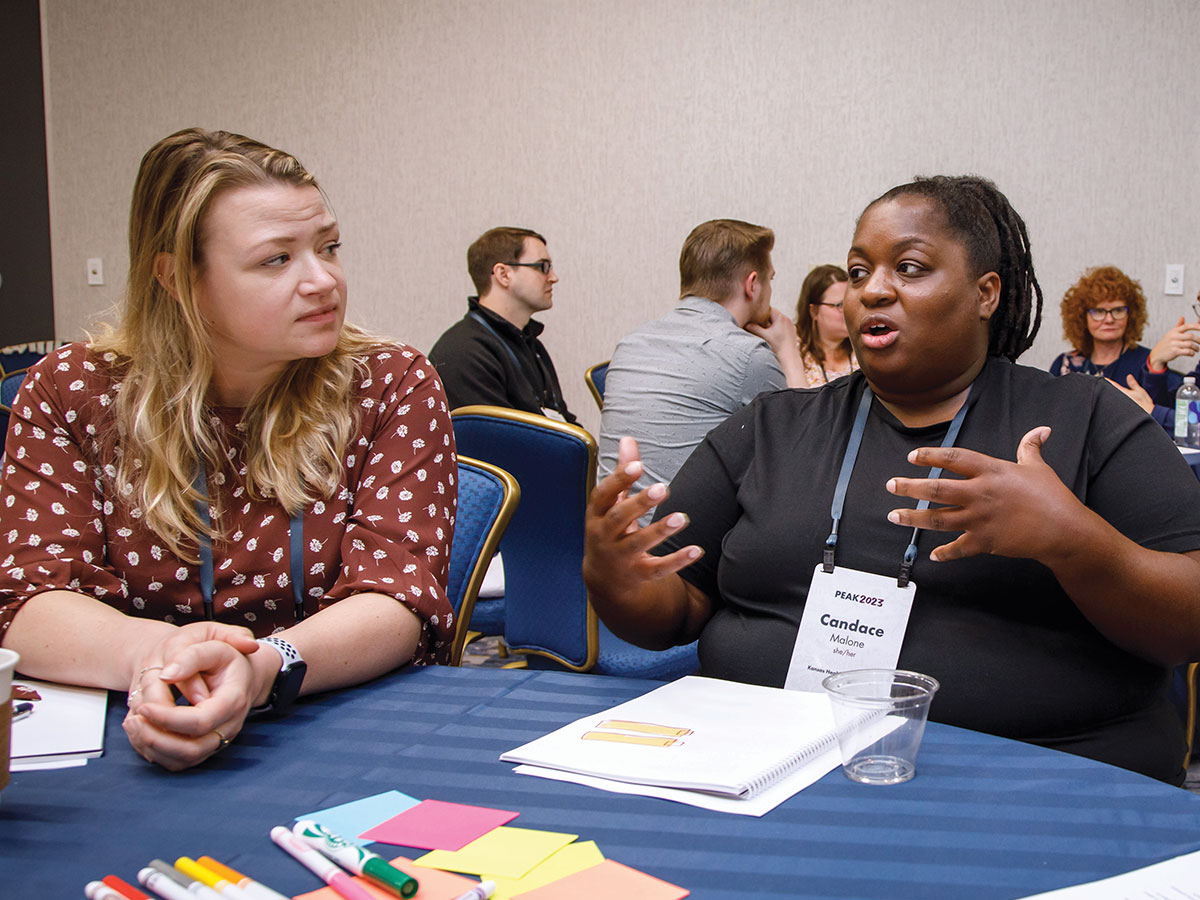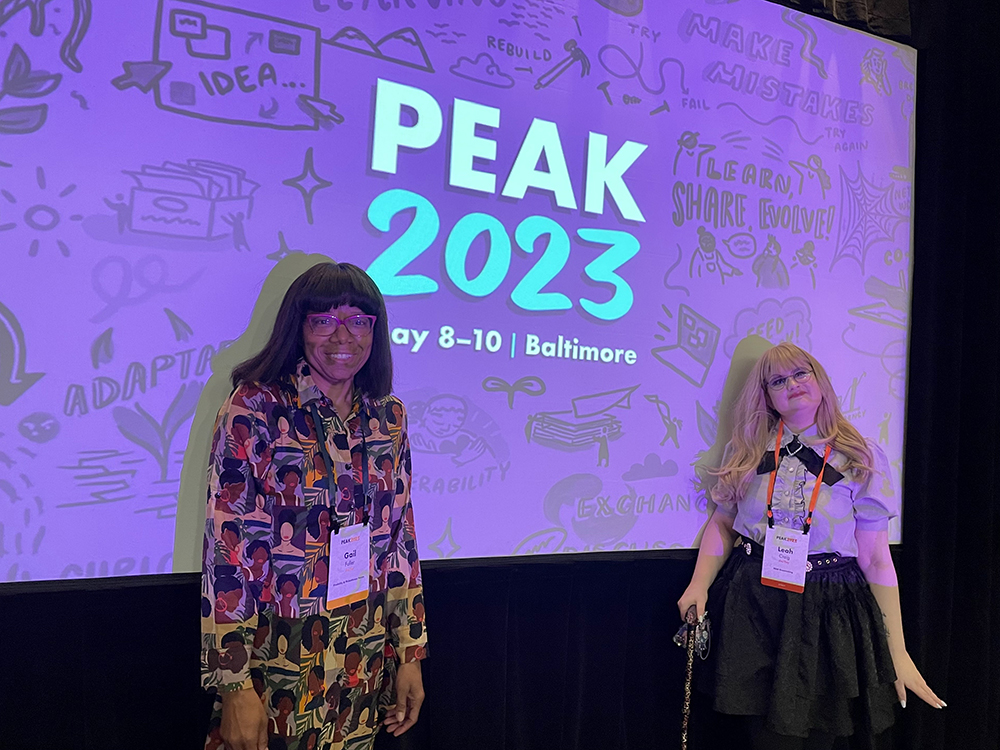Taking the Disability Inclusion Pledge: A progress report on PEAK’s journey

In early 2022, PEAK Grantmaking signed the Disability & Philanthropy Forum’s Disability Inclusion Pledge, a call to the entire philanthropic sector “to recognize that ableism—the systemic stigma and discrimination against people with disabilities—is a core barrier to equity and inclusion,” asking organizations to “commit to a continuing learning and implementation process that will advance systemic change … and serve as models for disability inclusion in the philanthropic sector.”
To support pledge signatories, the Forum created an action-planning framework, best-practice recommendations, and in-depth resources to support organization-wide adoption of accessibility practices across eight action areas—including disability-inclusive language, accessible events, team training and participation, inclusion audits, measurement, and reporting. Over the past year and a half, the PEAK team has tapped into those resources to embark on a staff learning journey that centers the perspectives of disabled people and to implement changes to improve accessibility across our platforms, policies, and practices.
Recognizing that we have much work ahead, we hope that these highlights of what we’ve learned thus far along our continuous learning journey will encourage you and your organization in joining us in advancing disability equity and inclusivity.
Self-assessment and learning
Our first step was completing the Forum’s assessment survey, reflecting on our current practices across the eight action areas. Right off the bat, we found that we could celebrate ways in which we had already taken action in addition to recognizing where we have work to do. We recognized that making progress depended on making this work an organization-wide commitment and that creating a staff learning plan was essential to building understanding, alignment, and teamwide ownership in implementing accessibility inclusion. We were also mindful that each colleague is at a different point in their own disability-inclusion learning journey.
We collaboratively designed a paced learning program with dedicated time and space for both self-directed and group learning experiences to better understand the perspectives and experience of people with disabilities and the scope of disability-inclusive practices. It kicked off with a spring 2023 staff meeting. To prepare, everyone read Demystifying Disability by Emily Ladau, a book about “what to know, what to say, and how to be an ally.” During the meeting, we dedicated time to discuss the book, disability-inclusive language, and have small-group discussions to explore open-ended questions. Here are a few of the big ideas that came from those conversations:
- Get comfortable with making people aware of hurtful language.
- Lean in on each other and help others find the right words, expand our vocabularies, and use language intentionally.
- Budget for accommodations knowing that they benefit everybody and consider how to expand on current accommodations to better support our community.
- Look for real-time learning opportunities in the work we do in our roles.
- Understand the intersectionality of this work.
In 2023, we started hosting watch parties, a series of informal group learning opportunities where staff members come together on Zoom to watch disability-inclusion webinars and share comments, questions, and takeaways in the chat. Our watch parties have featured virtual presentations focused on four areas of disability inclusion:
- Talking about disability
- Intersectionality of the disability community and communities of color
- Ableism in philanthropy
- Centering disability in leadership
These conversations and resources live in a dedicated Slack channel, which also serves as a place to share disability inclusion content in real time and has become a hub for sharing articles, reports, toolkits, webinars, and more. Staff also set up Forum accounts enabling them to delve into their in-depth member resources and programming.
Taking action
We developed a roadmap to guide our work and track progress across the eight action areas and document Forum recommendations and benchmarking results for PEAK and the signatories in aggregate. Here are a few highlights of our progress to date.
Disability community engagement: Living by the principle of “nothing about us without us,” we knew that fostering relationships with disability advocates in the sector would be central to our growth as an organization. Before signing the Pledge, we started content partnerships with the Forum and RespectAbility, a nonprofit whose mission is to fight stigmas and advance opportunities so people with disabilities can fully participate in all aspects of community. By simply offering them a platform to share their perspectives about disability inclusion within philanthropy via articles, chapter events, and at our national convening, we gained invaluable insight that helped us to frame our own action steps as an organization and were able to share those perspectives with our community at large. In continuing to build on those relationships, we were pleased to launch in spring 2023 a three-month fellowship program where we partnered with RespectAbility’s National Leadership Program to identify early-career professionals seeking to build a career in communications and to learn more about the philanthropic sector.
Inclusive language: Before signing the pledge, PEAK had already started building disability-inclusive language into our brand guidelines and used Stanford University’s Disability Language Guide and the Ford Foundation’s Disability Inclusion Toolkit to inform our approach. We also included guidance on when and how to mindfully use person-first and identify-first language and the importance of respecting how external contributors choose to describe themselves.
Measuring and reporting: Another Pledge goal asks that organizations track the disability status of staff and board members. According to civil rights advocate Chai Feldblum, “collecting disability data is key to increasing representation of people with disabilities at all levels within the organization.” PEAK annually surveys staff and board member demographics, including disability status, and shared aggregated results on our website, in our past two annual reports, and on our GuideStar profile.
Digital experience: Auditing our technology and website was a natural starting point for the communications team. Our web management partner Visceral only works with accessible website themes and page designs, so many best practices had already been implemented.
We identified a roadmap of new features and functionality to further improve accessibility, starting with the design of an enhanced digital experience for our Journal, one of the most-visited sections of our site. In February 2022, the Driving Racial Equity in Philanthropy issue debuted with a dynamic online presentation that was optimized for web accessibility. For example, we implemented photo backgrounds with text titles and descriptions on the landing page. This way the text is not embedded in images. We also aimed for contrasting content blocks on the landing page so text was readable and not lost in background color. We also used this helpful primer on how font choices affect accessibility.
Including alt text was a must, but we quickly realized there was an art to alt text. How much information to include and how descriptive to get opened the door to more conversations and learning. Articles like this were a help in determining what to describe based on the point of the image. When drafting alt text now, we ask ourselves two important questions: What purpose does this image serve in the context of the page, and what are the most impactful aspects of this image?
We also instituted standards for sharing videos, using Rev.com’s captioning and transcription services. While social networks can automatically generate captions for videos, this paid service allows us to edit and correct captions to ensure accuracy of names, organizations, and terms.
Events: For both in-person and virtual events, attendees are asked in advance to share what accommodations they need to fully participate.
When we meet virtually, we mainly use Zoom. Staff are currently learning how to enable auto-captioning on Zoom meetings. We’re also practicing how to give visual descriptions of ourselves with the help of resources like this video from Haben Girma about why visual descriptions are important and how you can approach sharing your description when meeting with people.
For PEAK2023, our programs team activated many suggested practices in addition to accommodating specific requests. They ensured that there were multiple opportunities for attendees to request accommodations, including when a person first registered for the convening, in follow-up communications leading up to the event, and at the registration desk for in-person attendees. Closed captioning was enabled for onsite and streaming sessions. Microphones were provided in all sessions, regardless of room size. When possible, session materials and agendas were provided in advance. In addition, all presenters went through an orientation that provided tips and techniques on how to be inclusive while presenting their sessions. Our team also ensured that the in-person spaces adhered to Americans with Disabilities Act access guidelines.
Written materials: As more PEAK staff began attending in-person events, business cards were becoming a greater need, so we explored how to make business cards more accessible. Through our research, we learned that while about 2.4 percent of the US population (7.6 million people) is considered legally blind, only around 7 percent of those individuals read Braille with many people with disabilities instead using assistive technologies built into smart devices. Consequently, we decided to include QR codes on the back of PEAK business cards that allow contact information to be shared virtually via Blinq. This has turned out to be one example of a practice that was initially adopted with accessibility in mind, but has benefited everyone. And as we can update our digital information, we eliminate the need to reprint paper business cards.
At PEAK2023 in Baltimore, handouts and some PowerPoint presentations also included QR codes. These pointed participants to digital materials, surveys, or other relevant resources. This allowed attendees to scan QR codes rather than typing in long URLs, which can be easily mistyped or misread. A happy surprise to us was how attendees were able to use their phones to scan from the back of the largest room when the QR code was on screen.
What’s next
To support our work, we’re exploring options for a disability-inclusion consultant partner to audit our practices, deliver staff training, and support implementations. This partner will be integral in pushing disability inclusion beyond our action plan and into our work. We’re also excited to continue staff learning with a Forum-led workshop for our staff this fall.
We’re still early in our journey, but the disability inclusion community continues to support our work and encourages us to celebrate every achievement. The people and organizations we’ve come to know make this work possible.
“This work is so important to the PEAK team and an integral component of our equity learning journey,” PEAK President and CEO Satonya Fair said. “These words by advocate and activist Corrinne Gray were shared in a recent watch party about ableism in our society: ‘If you embrace diversity, but ignore disability, you’re doing it wrong.’ That deeply resonated with me. PEAK is trying to do better every day and live this pledge. We’re emergent learners on this journey and we hope more organizations take up this work.”
Join us
PEAK signed on to the Disability Inclusion Pledge knowing that we had much work to do. That initial commitment has been transformative for our team, proving a powerful impetus to making tangible progress in advancing accessibility and in actively advocating disability inclusion, justice, and rights. We hope you will join us on the journey and welcome you to reach out to Senior Communications Director Betsy Reid if you have questions about our experiences or want to share yours.




